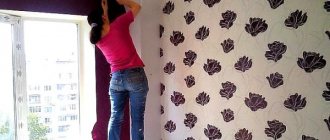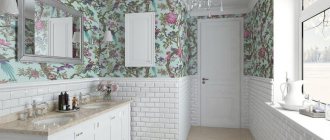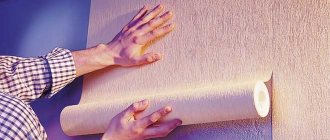Necessary information for calculation
Before calculating the amount of wallpaper per room, you need to find out several important parameters. They are usually known when you have already chosen the finish.
Options
- Roll width. The manufacturer labels each product, so it will not be difficult to find out this parameter. The standard size of most products on the market is 0.53 and 1.06 meters. There are exceptions. For example, for photo wallpapers or canvases that are made to order according to your measurements.
- Length of one roll. This parameter is also indicated by the manufacturer, the length starts from 10 meters and can even be 25 meters.
- Availability of a drawing. This is an important point in the question of how to calculate wallpaper for a room, since it is important to make adjustments so that the print looks correct and beautiful. Rapport is the correct name for the step of a pattern with which it is repeated. Typically the manufacturer indicates this step using special markings.
Sanderson
Options for joining fabrics with a pattern
The manufacturer indicates on the packaging a marking that indicates one of these docking methods.
- Free - that is, the strips are glued without following any rules. This is true for small or abstract prints.
- Straight - symmetry in gluing is important. That is, there is no need to move the rolls to join the patterns.
- Offset - in this case, the stripes need to be offset in order to adjust the pattern of the stripes to each other. Usually the markings have two numbers, which are written separated by a slash. The first number means the size of the repeat, the second is the number of centimeters by which the strip needs to be shifted.
- Counter - when each strip is reversed in relation to the previous one.
- Decoration Materials
8 mistakes when hanging wallpaper that are very easy to make
Features of wallpaper with rapport
A wallpaper report is a repetition of a pattern on a material, which can be lateral or vertical. If the pattern is repeated in width, you should check whether the overlap needs to be increased so that the wallpaper looks like a single whole. This information can be found on the rolls. Thanks to data on the type of pattern, it is easy to calculate how much wallpaper is needed for a certain room.
If the wallpaper needs to be adjusted according to the design, there will be much less waste. It is also important to pay attention to how the canvases should be positioned in relation to each other. In some cases, you have to turn the canvas over to create the correct pattern. On rolls of wallpaper with rapport it is usually written how many centimeters the canvas needs to be shifted to get a beautiful pattern.
Calculation around the perimeter of the room
Taking measurements
Stock up on a tape measure, pencil and paper. An important tip when taking measurements is to not round numbers, as this may lead to inaccurate final results.
Measure the walls, excluding the baseboards. Measure all layout features (alcoves, projections) separately. Record the received data on paper.
Next, take measurements for height. Since due to construction errors, ceiling heights may vary on different walls, take the largest figure as a basis.
We calculate the necessary parameters
- Perimeter. Add up the data for all the walls in the room.
- Number of sheets for pasting. This indicator will help you figure out the specific number of strips that will be needed for one room. You can find it out by the formula: perimeter divided by the width of the roll.
- Number of sheets in one roll. To find out this indicator, divide the length of the roll by the height of the wall. Add about 10 cm to the ceiling height for extra space.
Determining the number of rolls
And finally, the main thing is how to calculate the number of rolls of wallpaper per room. Divide the second indicator from the previous list by the third. If the number is not round, round it up.
Morris&Co
Morris&Co
How to calculate wallpaper for a room by area
We take the necessary measurements
For this you will again need a tape measure. Measure each wall, door and window in length. You will also need the ceiling height.
We calculate the necessary parameters
- Square one wall. To do this, multiply the length by the height. Repeat the process for each surface separately.
- The total area of all surfaces. To do this, you need to add up the indicators of each wall separately.
- General quadrature of openings. It is also calculated by adding the areas of windows and doors.
- A square that will be covered with wallpaper. Work according to the following formula: from the indicator of point two, subtract the number from point three.
- The area that one roll will cover. To do this, take the manufacturer's information about the length and width of the canvas and multiply them.
Determining the number of rolls
The final step is to divide the indicator from point four of the previous list by the area of one roll (point five). If the number is again not a whole number, round the number up.
Sanderson
Sanderson
Roll material counting
- All such calculations begin with calculating the perimeter of the room . The easiest way out is to add the length and width and multiply by 2. For example, if a room of the correct shape is 3x4m, then the total perimeter will be 14m².
- It’s good if everything is geometrically simple and of the correct shape . Often, in most apartments there are always various kinds of niches or projections. In this case, it is better not to be lazy and measure it with your own hands, on the floor using a tape measure.
- Experts have differing opinions about whether it is necessary to subtract windows and doors from the total area to be covered . In theory, of course, it should be subtracted; high-class professionals do just that. But if you do not have the proper experience, then it is better to leave everything together. This tolerance may be used for various kinds of bends and trims.
- The question of whether it is necessary to paste the walls behind the furniture remains on the conscience of the owners . In our opinion, if you are the owner of a good, high-quality headset and there is no point in changing it, then you should not glue wallpaper behind it. In this case, when taking measurements, there is no need to take into account the wall covered by furniture.
Calculation of rolls.
Advice: if the wall behind the furniture will not be covered with wallpaper, it must be well primed to prevent mold or mildew from forming. The most affordable option is to coat the surface with wallpaper glue.
Applying glue to the canvas.
- For canvases with a ready-made pattern, such a value as “rapport” must be taken into account . Rapport is the step with which the pattern is repeated on the canvas. Most manufacturers indicate this value directly in the passport. To properly combine the pattern, you need to add the size of the repeat to the height of the canvas.
- The height of the canvas is determined based on the height of the ceilings . The repeat value is added to this value, plus experts advise leaving a tolerance for trimming; it is within 7 - 10 cm.
- When counting strips, you should start from the width of the roll . Two standard sizes currently predominate on the market: 1 m and 53 cm. The instructions on the packaging must necessarily contain all this data. The total perimeter of the room must be divided by the width of the strip, the resulting value is rounded up to the nearest whole value. For example, the perimeter of a room we already know is 14 m, we divide these 14 m by the roll width of 53 cm, and after rounding we get 27 strips.
- You can calculate how many strips will come out of one roll by dividing the ceiling height, plus repeat, plus trimming allowance, by the length of the roll . Moreover, in this case, you should round in the opposite direction, to a smaller value.
Trimming the canvas.
Important: the amount of wallpaper for the ceiling is calculated slightly differently. The total square footage of the ceiling should be multiplied by a factor of 1.2. You will get the wallpaper consumption rate per 1 m2. To convert this value into rolls, it should be divided by the width of the web.
- After completing all these calculations, experts advise purchasing 1 extra roll as a reserve . If you do not have the proper experience, then when pasting with your own hands, there is a high probability of ruining 1 - 2 stripes. Plus, this supply may come in handy in the future if the coating gets dirty or damaged.
A few words about liquid wallpaper
Photo of liquid wallpaper.
- Liquid wallpaper is a finishing coating somewhat reminiscent of plaster. The mass is made on the basis of glue, cellulose fibers and special additives. It is supplied to the retail chain in dry form and prepared immediately before use.
- This coating can be applied manually, using a spatula and roller, or mechanically, using a special sprayer. On average, manufacturers promise that 1 kg of dry mixture is enough for 4 - 5 m² of wall. But you should not start from this value when calculating.
- The recommended application thickness for ideal walls ranges from 1.5 – 2.5 mm. But such walls are rare. Plus, professionalism is of great importance. If you are doing this for the first time, then 1 kg of dry mixture will be enough for a maximum of 3 m². But don’t be discouraged, as a rule, in 2 – 3 hours you will fill your hand.
- It is best to use a spray bottle. With a good pistol, even an amateur can work calmly and productively. When applying a solution to the wall, it is easy to simply control the thickness of the spraying and with this option, the consumption of the same kilogram of dry mixture increases to 5 - 7 m².
Dry mixture for liquid wallpaper.
Advice: much less composition will be needed if you first apply a special primer to the wall; it will close small pores and reduce the consumption of liquid wallpaper.
- Regardless of your level of professionalism, experts advise when purchasing dry composition to make a reserve of at least 500g. It may go towards unplanned expenses during spraying or be useful for fragmentary repairs later.
Tables that can help with calculations
There are special universal tables that take into account different roll widths. And the same length. Here are several such options. To use these tables, select the closest perimeter and ceiling height. The cross number of two lines will indicate the number of rolls.
Table for rolls 0.53 m wide and 10.05 m long
| Room perimeter | 6 | 10 | 12 | 14 | 16 | 18 | 20 | 22 | 24 | 26 | 28 | 30 |
| Ceilings up to 2.4 m | 3 | 5 | 6 | 7 | 8 | 9 | 10 | 11 | 12 | 13 | 14 | 15 |
| 2.5-2.7 m | 3 | 6 | 7 | 8 | 9 | 10 | 11 | 12 | 13 | 14 | 15 | 16 |
| 2.7-3.3 m | 4 | 7 | 8 | 10 | 11 | 12 | 14 | 15 | 16 | 18 | 19 | 20 |
Table for rolls 1.06 m wide and 10.05 m long
| Room perimeter | 6 | 10 | 12 | 14 | 16 | 18 | 20 | 22 | 24 | 26 | 28 | 30 |
| Ceilings up to 2.4 m | 2 | 3 | 3 | 4 | 4 | 5 | 5 | 6 | 6 | 7 | 7 | 8 |
| 2.5-2.7 m | 2 | 3 | 4 | 4 | 5 | 5 | 6 | 6 | 7 | 7 | 8 | 8 |
| 2.7-3.3 m | 2 | 4 | 4 | 5 | 6 | 6 | 7 | 8 | 8 | 9 | 10 | 10 |
The tables do not take into account the presence of a pattern and rapport. Therefore, add 1-2 rolls with a reserve if you decide to focus on them when purchasing.
Using a table to determine wallpaper consumption
To determine the amount of material required for a wall, you can use a wallpaper consumption calculator or use a table that makes it easy to check the calculations.
Calculation according to the tables provided is made without taking into account the selection of the pattern. When purchasing wallpaper with a pattern, you need to take into account that for every 6-7 rolls you need to take one additional one. For example, for a room of 24 sq. m with a ceiling height of more than 2.5 m, 15 + 2 = 17 rolls of standard size wallpaper will be required.
What to do if not all walls are covered with wallpaper or you need to combine them
Combining different finishing options, as well as focusing on one wall with a bright patterned panel, is a popular design technique. The calculation can be performed using one of the above schemes: perimeter or area. Only here it is important to take into account the footage of one wall or count separately for each wall on which a certain type of canvas will be pasted. And take into account the length and width of the canvas for different products.
If a decorative panel is made from canvases, then the area of this insert is calculated in the same way as the entire wall.
Sanderson
Sanderson
What is important to know when purchasing and paying
- Choose rolls from the same batch. Not only the color, but sometimes the size may differ from one to another. And this will significantly complicate your calculations.
- Evaluate the drawing. If you are not willing to overpay for a large expense, it may be worth abandoning printed canvases, since they inevitably lead to adjustments and cuts, which you will then have to either throw away or find a use for. Or focus on just one surface.
- By the way, about the use of segments. They can be used in different design solutions - for example, to make a picture from canvases with a pattern or to cover cabinet drawers. Plain sections can be used for pasting areas behind furniture. We just don’t recommend doing this with furnishings that you can move - a bed, a sofa, a chest of drawers. But the kitchen set is unlikely to change its position, so when gluing the surface behind it, it is quite possible to either save on material altogether, or use unnecessary pieces for this purpose.
- If the size of the doorway is small, up to 60 cm, it is usually not taken into account when calculating the area. It is assumed that there is a blank wall in place of the opening.
We described in detail how to calculate the amount of wallpaper per room. Use one of the methods described above and do not forget that you should always buy materials with a reserve - at least for one roll. In large hypermarkets, excess (given that they were not opened) can be returned using a receipt.
Borastapeter
Morris&Co











